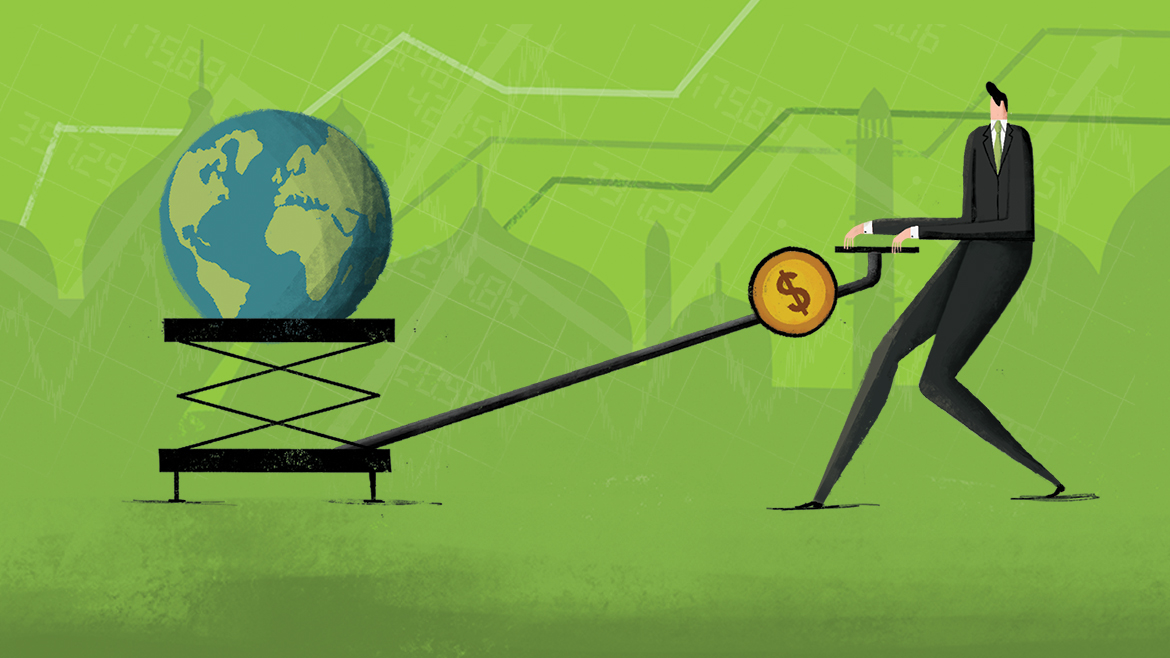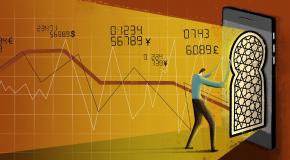The first green bonds were issued a little over a decade ago by multilateral institutions and municipalities. Green bond issuance is now growing by about 50% annually according to Sean Kidney, CEO and co-founder of the Climate Bonds Initiative, an investor-focused NGO based in London. Last year, green bond issuance reached a record of US$258bn, much of it coming from the US, France and China. “For investors, green bonds are a great way to address concerns about climate change and to put money in assets that they think are going to be lower risk,” says Mr Kidney.
The first shoots of a similar “green” instrument in the Islamic finance sector emerged not too long ago. In 2017, renewable energy group Tadau Energy issued the first “green” sukuk, raising US$59m to finance a solar power plant in Malaysia, the birthplace of conventional sukuk in the 1990s. Indonesia issued sovereign green sukuk worth US$1.25bn in 2018 and US$750m in 2019 to fund environment-related projects.
There is activity in the Arabian Gulf countries as well. In 2019 Majid Al Futtaim, a UAE-based retail company, raised US$600m with the region’s first corporate green sukuk. This was followed by a €1bn (US$1.12bn) green sukuk by Saudi-based Islamic Development Bank to finance renewable energy, green transportation and pollution control in its member countries.
Figure 1: Sukuk defined
Conventional sukuk |
|
Green sukuk |
A sukuk to finance renewable energy or other environmental assets. |
Sovereign green sukuk |
A green sukuk issued by a government entity. |
Corporate green sukuk |
A green sukuk issued by a private-sector organisation. |
Sources: Investopedia; Climate Bonds Initiative
A suitable match
Compared to conventional sukuk, the market for green sukuk is tiny. Conventional sukuk issuance totalled US$162bn in 2019, while the total outstanding debt for green sukuk amounts to only US$7.9bn, according to Mr Kidney. Yet some view it as a natural solution for low-carbon investment. Islamic finance is based on assumptions of fairness and social responsibility, and—while it has not always been observed—environmental stewardship is intrinsic to sharia principles.
“The fundamentals of Islamic finance share a lot with sustainable finance in terms of custodianship of the earth and responsible and ethical financing,” notes Michael Grifferty, president of the Gulf Bond and Sukuk Association.
Since sharia forbids the receipt of interest, sukuk are backed by assets and investors are paid an agreed share of the profits before being returned the principal at maturity. This structure gives them confidence that their capital is being used for a particular purpose. Assets eligible for green sukuk range from solar parks and biogas plants to renewable transmission networks and electric vehicles. They could also be used to finance green government subsidies.
The handful of issuances to date have been well received. Majid Al Futtaim’s sukuk was five times oversubscribed according to Hamed Ali, CEO of Nasdaq Dubai, the exchange on which it is listed. As Mr Kidney explains: “There are investors in Islamic countries who would never have invested in a green bond, but green sukuk is getting their attention. At the same time, there are international investors who invest in green bonds and like green sukuk as an extension of that market.”
Mr Grifferty says green sukuk can help issuers reach new investors. “It’s a great opportunity to access an investor-base which is much larger than the natural Islamic investor-base,” he explains. “Tapping into the sustainable and ethical investment-base could be helpful in terms of broadening the whole size and scope of the sukuk market.”
What’s holding the market up?
Still, green sukuk have not come as thick and fast as some proponents would like. This may be because issuers have been constrained by a shortage of certifiable green projects, notably in the oil-reliant economies of the Middle East.
“The big hurdle is in finding projects that are appropriate,” explains Mr Grifferty. “That means not only that they are sustainable, but also that they are measurable and appropriate in size and scope for capital markets financing.” In the Arabian Gulf, he sees more opportunity to invest in the transition to more sustainable economies—financing mitigation efforts such as reducing gas flaring or investing in carbon capture.
There are complexities in certifying the “green” credentials of an underlying asset and reporting on its performance, notes Debashis Dey, a UAE-based partner at the law firm White & Case. “I think there will be international investor demand for it [but] the question is whether GCC issuers are prepared to do the hard work to create these instruments,” he says. “You must have internal green policies, a proper framework of governance, say what you're going to do with the proceeds that qualifies to make it ‘green’, and report to investors as you use those proceeds.”
This may deter issuers, particularly in the Gulf where few companies have been pressured by regulation or shareholders to make environmental disclosures before. “If that changes, then there will be the drivers to push the market forward,” says Mr Dey.
A lack of pricing incentive may also have discouraged some issuers. “There’s a modest price benefit, a few basis points, but nothing massive,” Mr Kidney observes, though he adds that issuers favour green bonds “not for price, but [for] the strength of investor engagement”.
Growing the asset class: Leading by example
Mr Kidney hopes that more national issuance may pep up the market for green sukuk. “We are encouraging sovereigns to enter the market, like Indonesia has done, because that can play a pivotal role in benchmark pricing and growing liquidity,” he explains.
A sovereign green sukuk “is cooking” in Malaysia, he says, although it is unclear when it might be issued. Meanwhile “the Islamic Development Bank is actively encouraging its clients to do green sukuk, which is why they did their own as a demonstration,” he adds. Although the market is at a nascent stage, there are signs that it is gaining momentum. Mr Kidney is optimistic, estimating that issuance may double in size in 2020.
On the demand side, green sukuk growth will depend partly on that of the broader sukuk market. As Mr Ali of Nasdaq Dubai observes, “you need a thriving sukuk market to create a green version of it”. For conventional sukuk, he says there is demand from Western markets such as the US and Europe. The combination of investors seeking sharia-compliant investments and those with growing environmental, social and governance (ESG) priorities provides a wide investor base for green sukuk.
Mr Dey adds: “If you look at international funds, most of them now have some ESG component to their investment strategy. So if as an issuer you are wondering, ‘how do I create greater demand for my instrument?’, you could do something green, because that ticks a box for institutional investors.” If issuers can match investors’ intent with robust reporting—to demonstrate that funds are truly driving sustainable initiatives —green sukuk can play an important role in the race against climate change.
This is the first article in a series by The Economist Intelligence Unit on “Innovation in the Islamic Economy”. The next article will look at how fintech firms are reaching the next generation of Muslims.
[1] “Financing Climate Futures: Rethinking Infrastructure; Policy Highlights”, OECD/The World Bank/Un Environment, 2018. https://www.oecd.org/environment/cc/climate-futures/policy-highlights-financing-climate-futures.pdf
[2] Akhilesh Ganti, definition of “sukuk”, Investopedia, last updated April 30th 2019. https://www.investopedia.com/terms/s/sukuk.asp
[3] “2019 Green Bonds Market Summary, Climate Bonds Initiative, Februrary 2020. https://www.climatebonds.net/files/reports/2019_annual_highlights-final.pdf
[4] “Helping Malaysia Develop the Green Sukuk Market: Facilitating Sustainable Financing”, The World Bank, January 7th 2019. http://documents.worldbank.org/curated/en/586751546962364924/Helping-Malaysia-Develop-the-Green-Sukuk-Market-Facilitating-Sustainable-Financing-Case-Study.pdf
[5] “Indonesia issues world’s first green sukuk bond”, Financial Times, February 23rd 2018. https://www.ft.com/content/e38ea51c-184c-11e8-9376-4a6390addb44
[6] “World’s 1st Benchmark Corporate Green Sukuk”, Majid Al Futtaim, May 15th 2019. https://www.majidalfuttaim.com/en/media-centre/press-releases/2019/05/majid-al-futtaim-lists-world-s-first-benchmark-corporate-green-sukuk--on-nasdaq-dubai
[7] “Islamic Development Bank Achieves New Milestone with Debut Green Sukuk Worth EUR 1 Billion for Green Financing in its Member Countries”, IsDB, November 28th 2019. https://www.isdb.org/news/islamic-development-bank-achieves-new-milestone-with-debut-green-sukuk-worth-eur-1-billion-for-green-financing-in-its-member-countries
[8] Kudakwashe Muzoriwa, “Sukuk market to continue expanding in 2020, S&P Global”, Banker Middle East, January 13th 2020. https://www.cpifinancial.net/bme/news/sukuk-market-to-continue-expanding-in-2020-sp-global
[9] “IIFM Publishes Its Annual Sukuk Report 2019, USD 123.2 Billion Sukuk Issued Globally In 2018”, International Islamic Financial Market, July 31st 2019. https://www.iifm.net/iifm-publishes-its-annual-sukuk-report-2019-usd-123-2-billion-sukuk-issued-globally-in-2018/
[10] “Green Sukuk”, Climate Bonds Initiative, 2020. https://www.climatebonds.net/projects/facilitation/green-sukuk






